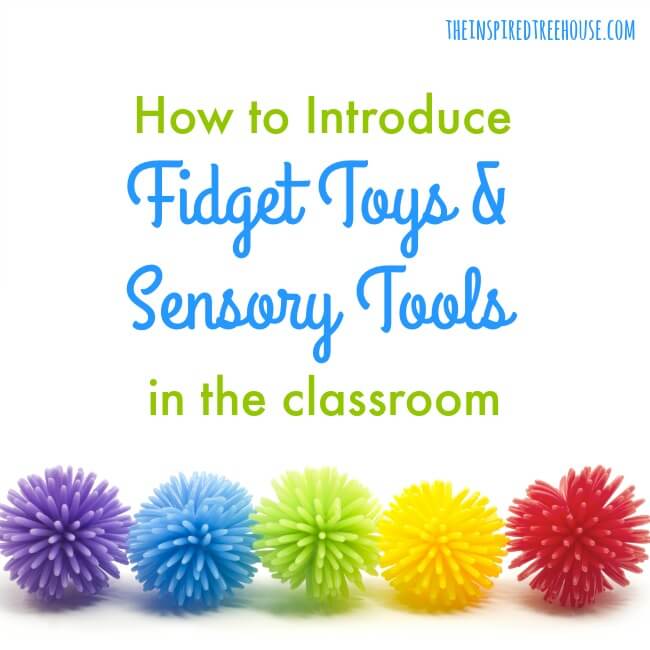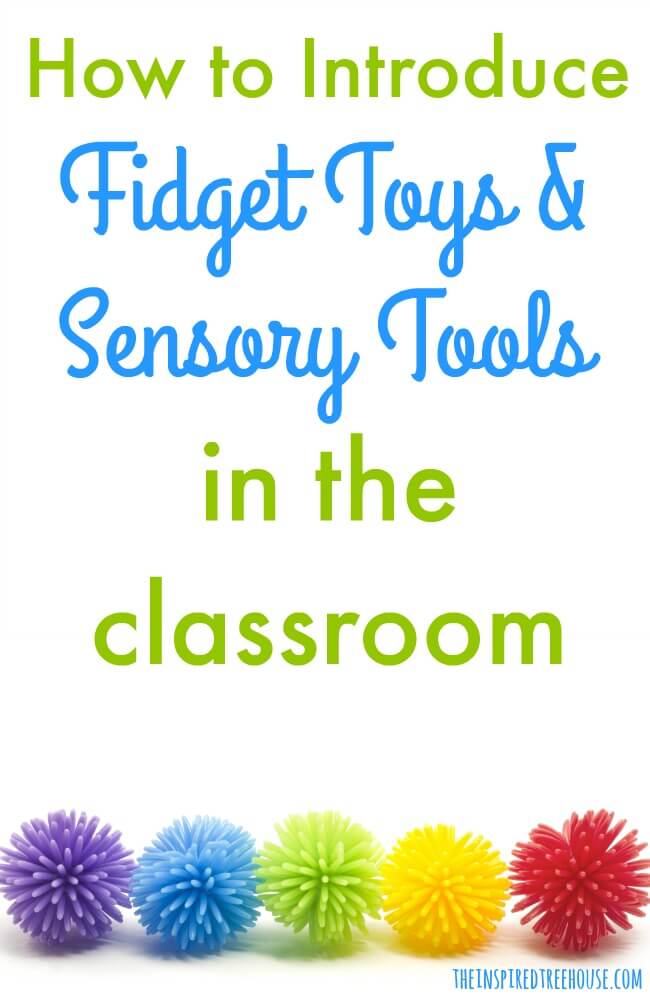Ever wonder how to introduce fidget toys and other sensory tools in the classroom setting? We’ve got you covered!
*This post contains affiliate links. Read more.
Today, we’re going to delve into a teacher-friendly, kid-friendly, and therapist-friendly approach to introducing fidgets and sensory materials into a classroom setting. If you’re a therapist, this would be an amazing multi-step, inclusion-based therapy plan.
If you’re a teacher, school psychologist, or guidance counselor who already has knowledge about sensory processing and you’re ready to take the leap on your own, this guide will be helpful to you as well!
What is a fidget?
A fidget is a small toy or object that a child (or an adult) manipulates in his or her hands while they’re reading, working, or listening.
Think about all of the ways we adults fidget throughout the day: we tap our pencil when we’re on a conference call, we twirl our hair while we wait at a traffic light, we play with a paperclip during a long meeting. Why?
Fidgets provide us with subtle movement and touch input that can help calm our bodies and keep our minds attentive, alert, and focused. Movement has been found to be a powerful component of focus and problem solving and fidgets provide an outlet for small movements of the hands while we work.
The need to fidget can be fulfilled by using something as complex as a commercially fabricated fidget toy with moving parts or something as simple as a piece of paper that someone folds and unfolds with their fingers. While some teachers and parents may think of fidgets as being distracting, when they are introduced in a thoughtful, structured way, they actually support students’ attention and learning rather than distracting from it.
How to Introduce Fidget Toys in the Classroom (Along With Other Sensory Materials)
1 || Introduce the sensory systems and talk about how they work.
No one can be expected to understand how to use fidget toys and other sensory materials if they don’t know how sensory processing really works.
And, if you’re picturing a good overview of the 5 senses (hearing, touch, sight, taste, and smell), you’re on the right track! But did you know that there are actually 7 sensory systems? Don’t forget to include an overview of the vestibular and proprioceptive systems too! These are the sensory systems that have to do with movement.
Give kids hands-on experience with their sensory systems and allow them to experiment with different types of sensory input while explaining how sensory processing works.
2 || Have kids explore their own unique sensory preferences
Now that everyone understands the sensory systems and how they all work together, it’s time to teach kids that we all have our own unique sensory needs and preferences.
Reassure kids that their sensory preferences and aversions, as long as they don’t stand in the way of daily life, are normal! They’re more than normal…they’re what make each of us special and unique!
Talk with them about the sensory experiences they find enjoyable and about the ones they really can’t stand. This is usually a really fun and lively discussion, as it validates everyone’s needs and differences.
3 || Make your sensory materials list
Once you’ve helped the kids identify their preferences and what works for them, make a list of the items and strategies you’ll include in your classroom fidget and sensory kit. Include items that will address the preferences and needs you’ve identified in the group of students.
Instead of calling the sensory materials “toys”, consider reframing the items as “tools” to support their learning.
Possible items to include in your kit:
–fidget toys
-CD or website with movement break songs/videos
-a quiet space in the room
-headphones with quiet music or white noise
-Old Soul Bracelets – Don’t miss these awesome and super stylish bracelets – perfect for fidgeting, hand strengthening, and targeting in-hand manipulation skills!
-pillows/cushions
–visual sensory bottles
-photos of different stretches or a yoga deck
–bean bag chair
–weighted lap pad or weighted blanket
–stretchy bands
–a rocking chair
–clipboards so kids can work in different places away from their desks
-scented lotion
-essential oils
-tactile bins
-putty or play dough
–weighted stuffed animals
-mints/gum
-bubbles
Ideally, you’ll have lots of options that will appeal to different types of sensory needs and preferences. Some kids will need sensory strategies for calming, others will need sensory strategies to help with attention.
4 || Have everyone pitch in.
Having kids help assemble and create their own DIY fidgets and other sensory materials creates a sense of ownership and responsibility. Bonus…it’s also super fun!!
Set a couple of class periods aside to have kids work together to make their own materials to add to the classroom sensory kit! In the list above, you’ll find links to a few DIY sensory tools. This is also a great time to demonstrate and let kids experiment with how the materials should be used. Maybe even some “what not to do” examples would be helpful too!
When you’re finished, have kids help to label, organize, and store the sensory tools in an accessible place in the room.
5 – Create a Sensory Kit Contract
Divide the sensory materials into two categories: items that can be used during learning activities and items that can be used at break times throughout the day. Discuss how and when kids can request the materials or if there are certain materials that they can access without needing to ask permission.
Examples of rules/responsibilities to include in your contract:
-Be responsible for the items in our sensory toolkit – take good care of our tools!
-Wait for break times to ask if you can use a break-time item from the sensory kit.
-Raise your hand to ask to use learning-time items from the sensory kit.
-The items in our Sensory Kit are for all of the students in our classroom. Share and take turns.
-Use the items wisely to help you pay attention and calm your body, not to distract yourself or others.
If these rules and expectations are a fit for your classroom, download and print a copy of our free fidget and sensory toolkit contract to post on the wall!
Check out this video about how to introduce fidget tools in the classroom!
What are your favorite ways to incorporate movement and sensory input in the classroom setting? Leave us a comment below!


Latest posts by Claire Heffron (see all)
- Cute Zipper Bags for Therapists - April 18, 2024
- Fairy Tale Games and Toys - April 12, 2024
- The Best Emotional Regulation Books for Kids - April 8, 2024


[…] kids are taught to identify and honor their preferences for movement, fidgeting, and alternative positioning, they feel that their needs are being acknowledged, contributing to […]